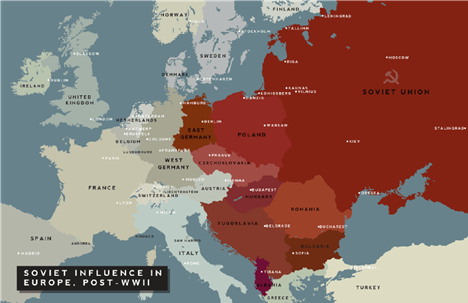 The Seven Year Jericho Prayer March Shortly after I returned from my two years National Service in the South African Infantry and had returned to Hospital Christian Fellowship, Brother Andrew (of God’s Smuggler fame) visited Hospital Christian Fellowship headquarters in Kempton Park. At the Devotions, he reported back on the success of Project Pearl smuggling a million Bibles into Red China. And he challenged us to join with Christians behind the Iron Curtain in a Seven-year Jericho Prayer March! This was not something being initiated in the West. It had already begun with the prayer meetings in Leipzig, East Germany, behind the Iron Curtain. We were challenged to a seven year prayer focus on bringing down the Iron Curtain, collapsing the Soviet Empire and opening up Eastern Europe and Russia to missionary work! To me, at the time, this sounded more than a bridge too far. I had seen the Iron Curtain. There was no doubt in my mind, at that time, that the Iron Curtain was an immovable fact of 20th Century history and it would be up until Jesus returned. The Fall of the Iron Curtain A speech at Westminster College, Fulton, Missouri, 5 March 1946, declared, “An Iron Curtain has descended across the continent.” From Stettin in the North to Trieste in the South, barbed wire and barricades, walls and machine gun towers were erected, sealing off the captive nations occupied by the Soviet Union from their neighbours in the West. The Iron Curtain divided a continent and trapped hundreds of millions of people under communism. Soviet dictator, Joseph Stalin, declared that the Second World War was not a disaster but “a great opportunity” to extend communism into the very heart of Europe. Poland Betrayed Even Poland, for whose freedom Great Britain had ostensibly entered the war, became little more than a satellite of the Soviet Empire ruled by men chosen by Moscow. Its population was now imprisoned behind a line of barbed wire, watchtowers and minefields, a physical iron curtain. Secret Police To spy on its captive populations the Soviet empire set up secret police. In the Soviet Union it was the KGB, in Bulgaria it was the DS, in Czechoslovakia the StB, in Hungary the AVB, in Poland the SB, in Romania the Securitate and in East Germany it was the STASI (the Ministry of State Security). The STASI maintained a huge network of 90,000 secret police and 175,000 paid informants. They kept files on 4,000,000 East Germans, a quarter of the population. Berlin Blockade The Berlin Wall was manned by 15,000 guards, the so-called Volkspolizei (VOPOS). When Joseph Stalin attempted to starve West Berlin into submission by cutting off all electricity and supplies on 23 June 1948, the Western powers responded with the Berlin Airlift. The Berlin blockade was the first serious global crisis of the Cold War. West Berlin was kept alive by an airlift of over 150 aircraft, supplying an average of 5,000 tons per day. By the time the Soviets ended the blockade on 12 May 1949, over 2.5 million tons had been delivered at the cost of 60 air-crew who had died in aircraft crashes. Korean War There were numerous hot fronts in the Cold War, including a fullscale military war in Korea where two million died in the three-year conflict. Evidence has since surfaced that Stalin was planning to follow up the Korean attack with a military offensive in Europe. He was deterred by the quick international response in Korea. Protests in Berlin After the death of Joseph Stalin (5 March 1953), over 100,000 East Berlin workers protested against the Soviet occupation. Two Soviet armoured divisions were sent into East Berlin to crush the protest in June 1953. Over 100 civilians were killed and 25,000 protesters arrested. Uprising in Hungary In July 1956, a full-scale uprising in Hungary shook the Soviet Empire. Mass demonstrations demanded the withdrawal of Soviet troops and in Budapest, a massive statue of Stalin was toppled. Soviet troops poured into Hungary and over 20,000 Hungarians were killed in the repression. Tensof-thousands more were arrested and imprisoned. 250,000 Hungarians fled to the West. 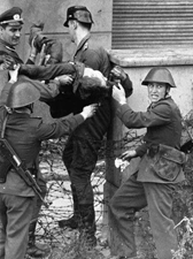 The Berlin Wall The Berlin Wall was concrete proof of the failure of “scientific socialism.” To prevent Germans in the Soviet zone from fleeing to the Western zone in Berlin, a 165 km wall was constructed to seal off West Berlin’s island of freedom from Soviet occupied communist East Germany. The Berlin Wall included 302 concrete observation posts/machine gun towers and 123 km of electric fencing. Death Strip A further death strip stretching 1,393 km along the border between communist East Germany and free West Germany was constructed with: 724 observation posts/machine gun towers, 1,161 km of electric fencing, 54, 000 self-firing devices and 190 km of mine fields. Kill Zone Just between 13 August 1961 and 30 July 1983, 73 people were killed by the communists while attempting to escape over the Berlin Wall, 182 more people were killed attempting to escape from East Germany across the border into West Germany, 60,000 people were imprisoned for “preparation, assistance or complicity”, in attempting to escape from East to West Germany (with sentences ranging from 16 months to life imprisonment). By 1989, at least 239 escapees from East Berlin were known to have been killed just at the Berlin Wall alone. Thousands died trying to flee across the Iron Curtain. 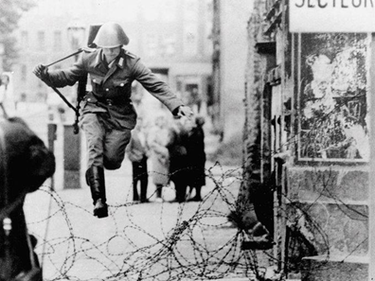 Voting With their Feet Yet from the founding of the German Democratic Republic (GDR) in 1949, more than 4,500,000 (over one quarter of the population) voted with their feet by fleeing to West Germany. 38,515 escaped from East to West Berlin by tunnels, by improvised air machines or hot air balloons, hidden inside vehicles travelling from East to West Berlin. 2,768 East German soldiers and officers on duty (including a Colonel) escaped to the West. Cuban Missile Crisis The Cold War almost went nuclear during the Cuban missile crisis, October 1962. The vicious conflicts in Vietnam, Laos and Cambodia, Rhodesia, Mozambique, Angola and South West Africa were hot parts of the Cold War. Invasion of Czechoslovakia Those who believed that communism could be reformed from within, were shaken by the Soviet invasion of Czechoslovakia in 1968, when Czech communist party chief, Alexander Dubcek, attempted to create “socialism with a human face.” As a result of economic reforms in Czechoslovakia, the other East European satellite states complained that their positions were being undermined by the reforms in Czechoslovakia. The Soviet response was: Leonid Brezhnev ordered a full-scale Warsaw Pact invasion of Czechoslovakia to restore orthodox communism. The Prague Spring ended in August 1968 as half-a-million Warsaw Pact troops invaded Czechoslovakia and overwhelmed the courageous resistance of Czech patriots. Détente Deception The Soviet Empire reached its peak during the period of Détente, as they sponsored, trained and armed revolutionaries to seize power in Cambodia, Laos and Vietnam in 1975, Ethiopia in 1974, Guinea Bissau, Angola and Mozambique in 1975, Grenada and Nicaragua in 1979 and Rhodesia/ Zimbabwe in 1980. The Soviet invasion of Afghanistan in 1979 was a major wake up call to those in the West who still believed in Détente. Freedom on the Offensive As a result of this unprecedented Soviet advance, there was a backlash throughout the West, epitomised by staunch anti-communist US President, Ronald Reagan, British Prime Minister, Margaret Thatcher, West German Chancellor, Helmut Kohl and South Africa’s P.W. Botha. South Africa confronted and defeated the Soviets and their Cuban surrogates in Angola. The West went on the offensive, directly supporting the anti-communist Solidarity trade union movement in Poland, which soon organised nationwide strikes and protests against the Soviet occupation. The USA began to arm and support anti-communist resistance movements as far afield as in Nicaragua, Afghanistan and Angola. Bankrupting the Soviets Ronald Reagan’s policies forced the Soviets back onto the defensive and strategically undermined their economy. Spectacular re-armament programmes and the space based Strategic Defence Initiative (SDI) quickly left the Soviets far behind in the arms race and totally bankrupted the Soviet Union in their futile attempt to keep up with America. The Iron Lady British Prime Minister, Margaret Thatcher’s determination to fight to reclaim the Falkland Islands, after the Argentinean invasion, helped convince the Soviets that the West was not nearly so decadent and weak as they had imagined. Thatcher’s success in reviving the British economy also helped demonstrate that capitalism had a future even while communism was bankrupting the Soviet Union in Eastern Europe. The Iron Lady had this to say about the Berlin Wall: “The Berlin Wall stands as concrete proof that when people have a choice, they choose to be free. Freedom has its problems, but we’ve never needed to build walls to keep our people in!” Defeating the Communists Brave anti-communist resistance fighters in Mozambique, Angola, Nicaragua and Afghanistan severely bled the Soviet forces, inflicting serious defeats upon them. The Rhodesian resistance throughout the 60s and 70s had set back the advance of communism in Southern Africa and the destruction of entire Cuban-mechanised divisions in Angola by South African conventional forces in the battles on the Lomba River in 1987 and 1988, convinced the Soviet Union that they would not even be able to win a conventional war against the West. Recognising Reality Russian soldiers began to refer to Afghanistan as their ‘Vietnam’. As Russian casualties mounted in that conflict, the ongoing political crisis in Poland and widespread resistance to communism throughout the Soviet empire helped convince the Soviet leaders that their bankrupt system was doomed. The Glasnost Gulag Even under Gorbachev’s much-acclaimed Glasnost, the Soviet Gulag imprisoned millions. When US President, Ronald Reagan, stood at the Berlin Wall and challenged: “Mr Gorbachev, tear down this wall!” the Soviet Union operated 1,976 concentration camps, 273 prisons, 85 psychiatric prisons and 41 death camps. In this Soviet Gulag, over 5,000,000 political and religious prisoners were incarcerated. Alexander Solzhenitsyn, author of The Gulag Archipelago, documented that between 1918 and 1953 (under Lenin and Stalin’s rule) over 50,000,000 Russians served long sentences in the Soviet concentration camps, with millions perishing. The Hypocrisy of Communism It was pointed out that while the communists claimed to have liberated Russia from the oppression of the Czars, there were 5000 times more official executions under communist rule in Russia as occurred under Czarist rule in the same time period. By comparison with Russia under Czarist rule where the highest figure of political prisoners was 183,949, the communists imprisoned seventy times as many people at any one time. Callous Disregard for Life Vladimir Lenin famously declared that it did not matter if three quarters of the population of Russia perished, as long as the remaining quarter were communist. Joseph Stalin observed: “The death of one person is a tragedy; whereas the death of a million is just a statistic!” 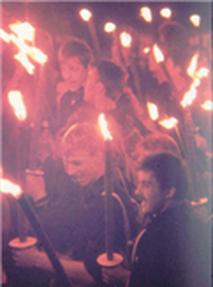 Prayer and Protests As candlelit prayer vigils and protests spread from Leipzig, through Dresden, to all of East Germany, the East German government was bankrupt and tottering. Gorbachev’s Soviet Union was also bankrupt and could no longer bail them out. So, Erich Honecker, the dictator of East Germany, turned to the West Germans (who in the past had always been willing to provide enough to keep East Germany going). This time, however, the West German Federal Government was not willing to bail them out. They demanded reforms. The Fall of the Wall While governments negotiated, the people in both East and West Berlin rose up to breach the wall and began to dismantle it physically. The leaders were overwhelmed by events. Days after the Berlin Wall collapsed, mass demonstrations broke out in Czechoslovakia. Vaclav Havel, long-time leader of the Resistance movement and prisoner of the communists, rose to power and dismantled communism in Czechoslovakia. 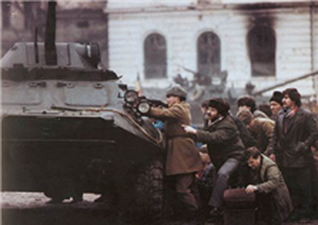 The Fall of the Wall While governments negotiated, the people in both East and West Berlin rose up to breach the wall and began to dismantle it physically. The leaders were overwhelmed by events. Days after the Berlin Wall collapsed, mass demonstrations broke out in Czechoslovakia. Vaclav Havel, long-time leader of the Resistance movement and prisoner of the communists, rose to power and dismantled communism in Czechoslovakia. The Christmas Revolution Street fighting erupted in Romania to overthrow the brutal communist dictator Nicolae Ceausescu. Soon resistance spread to Bulgaria where the communists were overthrown in December 1989. In Hungary, the communist government was overthrown in October 1990. In Albania, the first free elections were held in March 1991. Yugoslavia split into different republics as each broke away from the communist control in Belgrade. Soon the Baltic Republics, Estonia, Latvia and Lithuania, were demanding and achieving their independence from the Soviet Union. 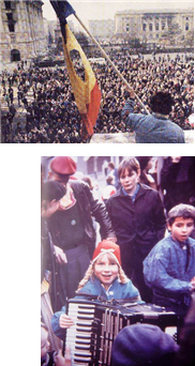 The End of the Soviet Union In August 1991, a coup in the Soviet Union was frustrated in its attempt to return the country to hard-line communism. Boldly waving the white, blue and red Russian flag, Boris Yeltsin abolished the Soviet Union and pulled down the Soviet Flag. The Cold War had formally ended. Victory Over Communism “There is nothing they despise more than weakness. There is nothing they respect more than strength.” The Cold War was won by a combination of Christian courage by persecuted Christians who endured decades of brutality, steadfast resistance by brave anti-communist soldiers who fought the Soviets to a standstill, persistent prayer and pressure from Christians in the West and the bold strategy of Ronald Reagan, which dismantled the Evil Empire. “While they promise them liberty, they themselves are slaves of corruption…” 2 Peter 2:19 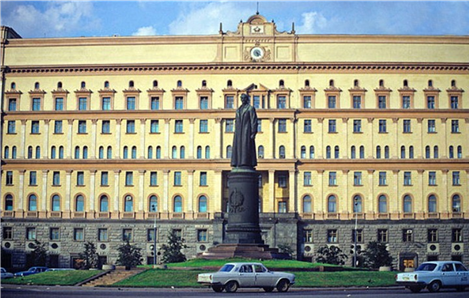 The Statue and the Stone In Lubyanka Square, in Moscow, about 900m North East of Red Square, a huge statue of Felix Dzerzhinsky, the founder of the Cheka, which later became the NKVD and then the KGB, was erected in 1958. This statue was directly in front of the Lubyanka, the notorious Headquarters of the KGB, wherein many Christians were interrogated, tortured and murdered. In 1991, the statue of Dzerzhinsky was removed and a simple stone from the Monastery on Solovetski Island, which had been the first prototype Concentration Camp of the Soviet Union, was placed in the square where the statue of Dzerzhinsky had once stood. The symbolism of the Victory of Christ over Communism is striking. 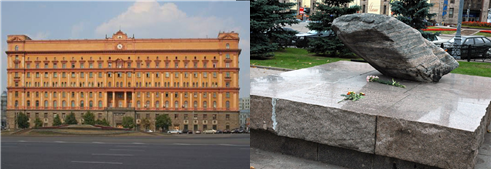 The Lord Jesus Christ declared: “The Stone which the builders rejected has become the chief Cornerstone. Whoever falls on that Stone will be broken; but on whomever it falls, it will grind him to powder.” Luke 20:17-18 (Matthew 21:44) 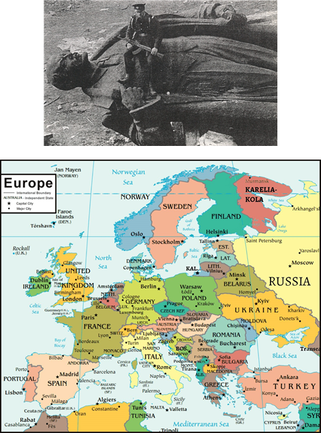 “But there is a God in Heaven Who reveals secrets… This great image, whose splendour was excellent, stood… a Stone was cut out without hands, which struck the image on its feet of iron and clay, and broke them in pieces… And the Stone that struck the image became a great mountain and filled the whole earth… And in the days of these kings the God of Heaven will set up a Kingdom which shall never be destroyed; and the Kingdom shall not be left to other people; it shall break in pieces and consume all these kingdoms and it shall stand forever.” Daniel 2:28-44 This article is adapted from a chapter in Frontline: Behind Enemy Lines for Christ https://www.christianlibertybooks.co.za/item/frontline__behind_enemy_lines_for_christ_pb 12 November is International Day of Prayer for the Persecuted. Visit www.idop-africa.org for resources to mobilize prayer and action on behalf of those suffering for Christ. Written by: Dr. Peter Hammond [email protected] PO Box 74 | Newlands | 7725 | Cape Town | South Africa Tel: +27 21 689 4480
0 Comments
Leave a Reply. |
.
Categories
|
Archives
Articles Sorted by Date
November 2023
October 2023
September 2023
October 2021
April 2021
June 2020
May 2020
April 2020
March 2020
February 2020
October 2019
August 2019
June 2019
February 2019
August 2017
January 2017
November 2016
March 2016
January 2016
June 2012
May 2012
November 2010
August 2004
August 1993
June 1993
June 1991
August 1989
June 1989
 RSS Feed
RSS Feed
